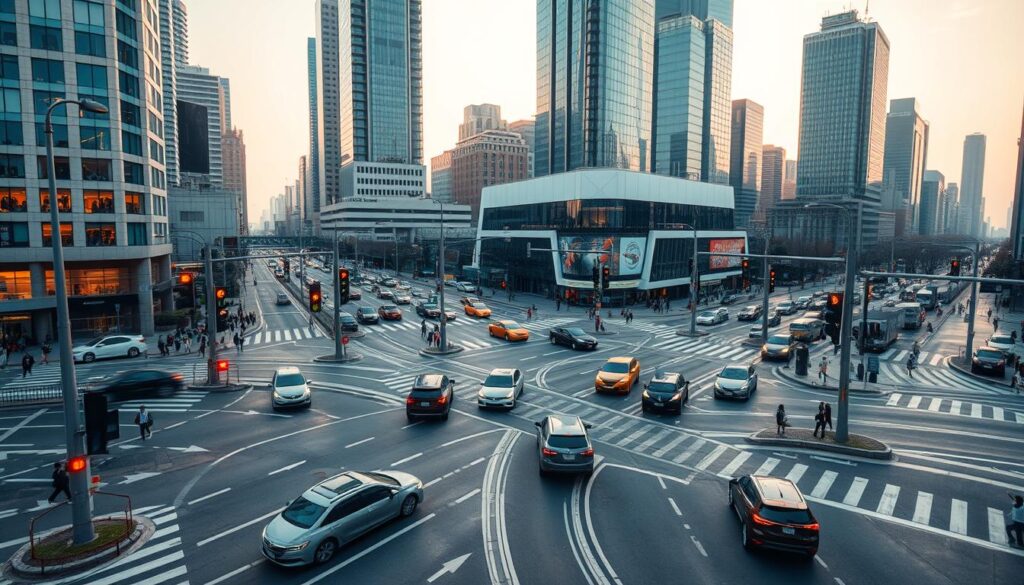Are you tired of being stuck in congestion on your daily commute?
Traffic flow engineering plays a crucial role in ensuring the safety and efficiency of roadways. By understanding traffic patterns and implementing effective management strategies, engineers can significantly enhance the commuting experience.
Effective transportation engineering involves designing and implementing improvements to transportation networks, making daily commutes smoother and safer.
Key Takeaways
- Understanding traffic patterns is crucial for optimizing traffic flow.
- Effective traffic management strategies can reduce congestion.
- Transportation engineering plays a vital role in enhancing commute experiences.
- Innovative solutions in traffic flow engineering are continually being developed.
- Improving roadway safety is a key goal of traffic flow engineering.
What is Traffic Flow Engineering?
Traffic flow engineering plays a pivotal role in the planning, design, and operation of transportation infrastructure. It is a critical component of transportation engineering that focuses on managing and optimizing the flow of traffic to reduce congestion and improve travel times.
Definition and Importance
Traffic flow engineering is defined as the application of scientific principles and techniques to manage traffic flow. It involves the use of traffic control systems to monitor and control traffic conditions, ensuring safe and efficient travel. The importance of traffic flow engineering lies in its ability to mitigate traffic congestion, reduce travel times, and improve air quality.
Effective traffic flow engineering is crucial for modern transportation systems, as it helps to optimize the use of existing infrastructure, reducing the need for costly expansions or new constructions. By implementing intelligent traffic control systems, cities can better manage traffic flow, reducing congestion and improving overall traffic efficiency.
Historical Context
The field of traffic flow engineering has a rich history, dating back to the early 20th century when the first traffic signals were introduced. Over the years, it has evolved significantly, incorporating new technologies and methodologies to address growing traffic demands. The development of intelligent transportation systems (ITS) has been a significant milestone, enabling real-time monitoring and management of traffic flow.
Key Objectives of Traffic Flow Engineering
The primary objectives of traffic flow engineering include optimizing traffic signal timing, improving traffic signal coordination, and implementing effective traffic management strategies. These objectives are achieved through the use of advanced traffic control systems and data analysis techniques.
- Optimizing traffic signal timing to reduce congestion
- Improving traffic signal coordination to enhance traffic flow
- Implementing effective traffic management strategies to mitigate the impact of incidents
By achieving these objectives, traffic flow engineering contributes to safer, more efficient, and more sustainable transportation systems.
Fundamental Concepts in Traffic Engineering
Traffic engineers use various fundamental concepts to analyze and optimize traffic flow. Understanding these basics is crucial for designing effective traffic management strategies.
Traffic Streams and Flow Characteristics
Traffic streams refer to the flow of vehicles on a roadway, and understanding their characteristics is vital for traffic analysis. Key characteristics include speed, density, and flow rate. Traffic flow modeling is used to simulate real-world traffic conditions, helping engineers predict how different factors affect traffic flow. For instance, traffic flow models can simulate the impact of increased traffic volume on roadways.
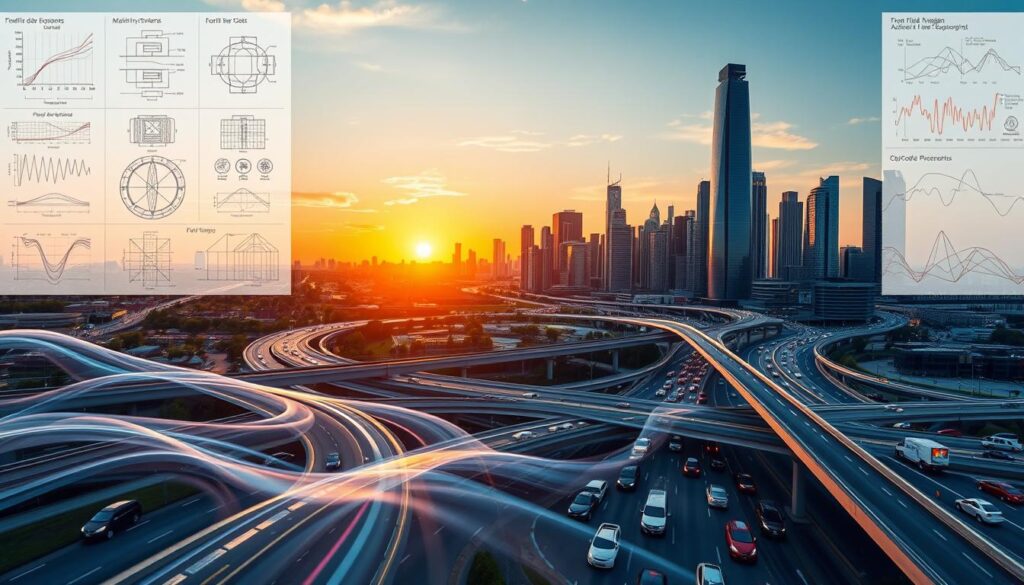
Capacity and Level of Service
The capacity of a roadway refers to the maximum number of vehicles it can handle in a given time period. Level of Service (LOS) is a measure used to evaluate the operational status of a roadway, ranging from LOS A (free flow) to LOS F (forced or breakdown flow). Understanding capacity and LOS is essential for designing roadways that meet traffic demands. Traffic analysis software is often used to assess the capacity and LOS of roadways.
- LOS A: Free flow, with low traffic volumes and high speeds.
- LOS B: Reasonable free flow, with moderate traffic volumes.
- LOS C: Stable flow, but with noticeable restrictions.
- LOS D: Approaching unstable flow, with significant restrictions.
- LOS E: Unstable flow, with high traffic volumes and low speeds.
- LOS F: Forced or breakdown flow, with extremely high traffic volumes and congestion.
Traffic Volumes and Measurements
Traffic volumes refer to the number of vehicles passing a given point on a roadway over a specific period. Accurate traffic volume measurements are critical for traffic engineering. These measurements help engineers understand traffic patterns, identify trends, and make informed decisions about traffic management. For example, AutoCAD Civil 3D can be used for designing and analyzing roadways based on traffic volume data.
By grasping these fundamental concepts, traffic engineers can develop effective strategies to optimize traffic flow and reduce congestion.
Traffic Flow Theory: An Overview
Traffic flow theory encompasses various models and theories that describe traffic behavior under different conditions. It is a critical component of transportation engineering, helping engineers and planners design and manage traffic systems efficiently.
Key Models and Theories
Several key models and theories form the basis of traffic flow theory. These include:
- Lighthill-Whitham-Richards (LWR) Model: A fundamental model that describes traffic flow using a continuity equation.
- Car-Following Models: These models examine how vehicles follow each other on a roadway, influencing traffic flow and stability.
- Traffic Flow Models: Various models that simulate traffic flow under different conditions, such as free-flow, congested, and breakdown conditions.
These models help in understanding the dynamics of traffic and in developing strategies to mitigate congestion.
Fundamental Diagram of Traffic Flow
The fundamental diagram of traffic flow is a graphical representation showing the relationship between traffic flow, density, and speed. It is a crucial tool in traffic flow theory, providing insights into the capacity of roadways and the conditions under which traffic flow becomes unstable.
The diagram typically plots flow against density, illustrating the transition from free-flow conditions to congested conditions. Understanding this diagram is essential for traffic engineers to design and manage traffic systems effectively.
| Traffic Condition | Flow (vehicles/hour) | Density (vehicles/km) | Speed (km/h) |
|---|---|---|---|
| Free Flow | Low | Low | High |
| Congested | High | High | Low |
| Optimal | Maximum | Optimal | Moderate |
By analyzing the fundamental diagram and other traffic flow models, transportation engineers can develop strategies to optimize traffic flow, reduce congestion, and improve overall traffic management.
Traffic Management Strategies
Traffic management strategies play a vital role in optimizing traffic flow and enhancing road safety. Effective traffic management is essential for reducing congestion, decreasing travel times, and improving the overall efficiency of transportation systems.
Signal Control Techniques
Signal control techniques are a critical component of traffic management. By optimizing traffic signal timings, traffic engineers can significantly reduce congestion and improve traffic flow. Advanced signal control systems use real-time data and sophisticated algorithms to adjust signal timings based on current traffic conditions.
Key benefits of advanced signal control techniques include:
- Reduced congestion through optimized signal timings
- Improved traffic flow and reduced travel times
- Enhanced safety through reduced red-light running and improved pedestrian crossings
Roundabouts and Intersections
Roundabouts and intersections are critical points in the traffic network where careful design and management are essential to prevent congestion and reduce the risk of accidents. Roundabouts, in particular, have been shown to reduce accident rates and improve traffic flow compared to traditional intersections.
| Design Element | Traditional Intersection | Roundabout |
|---|---|---|
| Traffic Signals | Required | Not Required |
| Accident Rate | Higher | Lower |
| Traffic Flow | Interrupted | Continuous |
Incident Management and Response
Incident management and response are crucial for minimizing the impact of accidents and other incidents on traffic flow. Effective incident management involves quick response times, efficient clearance of incidents, and real-time information dissemination to drivers.
Key components of effective incident management include:
- Rapid detection and response to incidents
- Coordination between emergency services and traffic management centers
- Real-time information to drivers through dynamic message signs and mobile apps
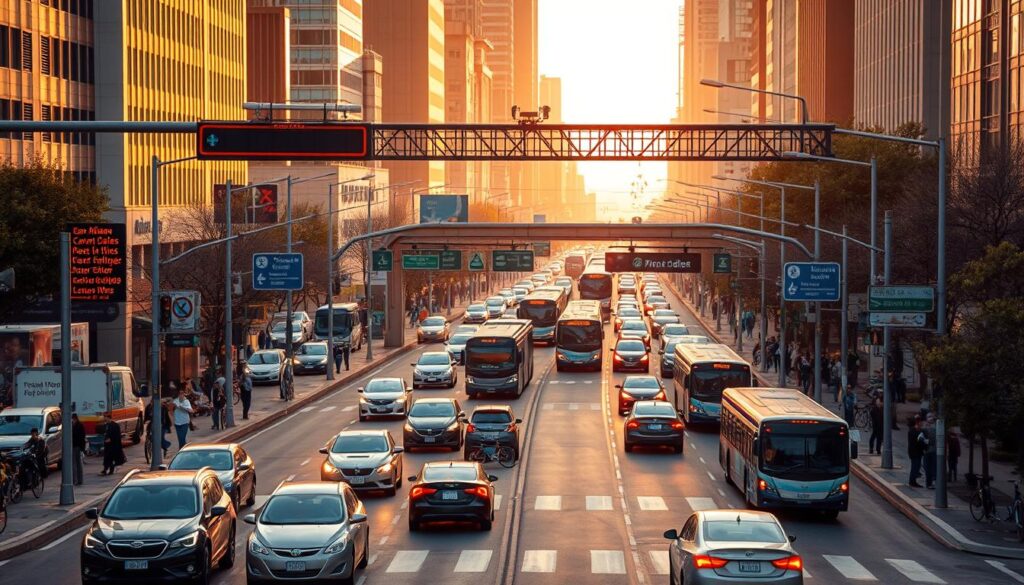
The Role of Technology in Traffic Flow
Advancements in technology are transforming traffic flow engineering. The field is witnessing significant improvements with the integration of various technological innovations. These advancements are not only optimizing traffic flow but also enhancing safety and reducing congestion.
Intelligent Transportation Systems (ITS)
Intelligent Transportation Systems (ITS) are a crucial part of modern traffic management. ITS integrates advanced technologies such as real-time data collection, communication networks, and data analytics to manage traffic flow efficiently. For instance, technologies that help drivers maintain safe following can significantly improve road safety and traffic flow.
Real-time Traffic Data and Apps
Real-time traffic data and mobile applications are revolutionizing the way people navigate through cities. These tools provide commuters with up-to-the-minute traffic information, helping them make informed decisions about their routes. As a result, traffic congestion is reduced, and travel times are minimized.
Automated Vehicles and Traffic Engineering
Automated vehicles are poised to have a significant impact on traffic flow engineering. With their ability to optimize speed and reduce human error, they can potentially decrease congestion and improve safety. The integration of automated vehicles into existing traffic systems requires careful planning and infrastructure adjustments.
| Technology | Impact on Traffic Flow | Benefits |
|---|---|---|
| Intelligent Transportation Systems (ITS) | Optimizes traffic signal timing | Reduces congestion, improves safety |
| Real-time Traffic Data and Apps | Provides real-time traffic updates | Minimizes travel time, reduces congestion |
| Automated Vehicles | Optimizes speed, reduces human error | Improves safety, decreases congestion |
Improving Urban Traffic Flow
Urban planning plays a vital role in reducing congestion and enhancing traffic flow. Effective urban planning is essential for creating a well-functioning transportation system that meets the needs of a growing urban population.

Urban Planning and Design Principles
To improve urban traffic flow, several key urban planning and design principles should be considered. These include:
- Compact and Connected Urban Design: Encouraging mixed-use development and dense, walkable neighborhoods can reduce the need for lengthy commutes.
- Multimodal Transportation Systems: Incorporating various modes of transportation, such as public transit, pedestrian, and cycling infrastructure, can help distribute traffic more efficiently.
- Smart Traffic Management: Implementing intelligent transportation systems (ITS) can optimize traffic signal timing and provide real-time traffic information to commuters.
For more information on the role of transportation engineers in urban planning, visit what does a transportation engineer do.
Case Studies of Successful Projects
Several cities have implemented successful urban traffic flow improvement projects. For example:
- New York City’s Times Square Redevelopment: This project transformed a congested area into a pedestrian-friendly zone, reducing traffic congestion and improving air quality.
- Copenhagen’s Bicycle Infrastructure: By investing heavily in cycling infrastructure, Copenhagen has encouraged more residents to use bicycles, reducing reliance on cars and decreasing traffic congestion.
These case studies demonstrate the effectiveness of well-planned urban design and transportation strategies in improving traffic flow.
Methods for Analyzing Traffic Patterns
The analysis of traffic patterns involves a range of techniques, from simulation software to data collection methods. Traffic engineers use these methods to understand traffic behavior, identify areas for improvement, and develop strategies to optimize traffic flow.
Simulation Software and Tools
Simulation software is a critical tool in traffic analysis, allowing engineers to model various traffic scenarios and predict the outcomes of different interventions. Traffic analysis software such as VISSIM and Aimsun enable detailed simulations of traffic flow, helping to identify potential bottlenecks and test solutions before implementation.
Some of the key features of simulation software include:
- Modeling of complex intersections and interchanges
- Simulation of various traffic conditions, including peak hours and incidents
- Analysis of traffic signal control strategies
Data Collection Techniques
Accurate data collection is fundamental to understanding traffic patterns. Data collection techniques range from traditional methods like loop detectors and cameras to more advanced technologies such as radar sensors and GPS data analytics.
| Method | Description | Advantages |
|---|---|---|
| Loop Detectors | Embedded in the road surface, these detectors measure traffic volume and speed. | Reliable for traffic volume data |
| Cameras | Used for monitoring traffic conditions and incidents. | Provide visual data, useful for incident detection |
| Radar Sensors | Measure traffic speed and volume with high accuracy. | High accuracy, less affected by weather conditions |
Traffic Safety Assessment
Traffic safety assessment is a critical component of traffic analysis, focusing on identifying potential safety hazards and developing strategies to mitigate risks. This involves analyzing crash data, assessing road geometry, and evaluating the effectiveness of safety measures.
By combining simulation software, data collection techniques, and traffic safety assessments, traffic engineers can develop comprehensive plans to improve traffic flow and safety. These methods, when used together, provide a powerful toolkit for optimizing traffic management and enhancing the overall commuting experience.
Environmental Considerations in Traffic Flow
As traffic congestion continues to rise, environmental considerations in traffic flow engineering have become increasingly crucial. The impact of traffic on the environment is multifaceted, affecting air quality, noise pollution, and overall sustainability. Traffic flow engineering must now prioritize reducing these negative environmental impacts.
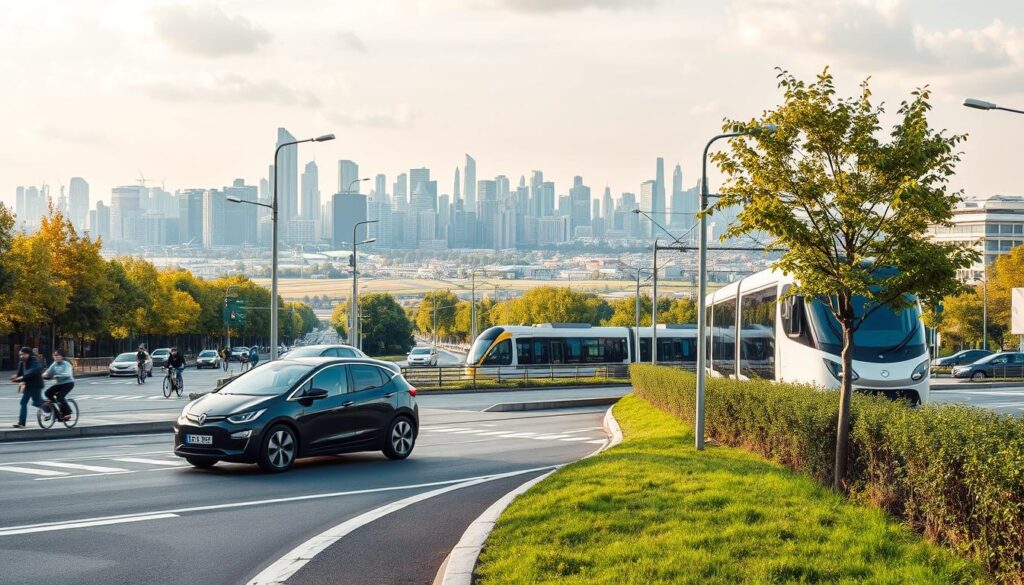
Impact of Traffic on Air Quality
Traffic significantly contributes to air pollution, emitting harmful pollutants such as particulate matter (PM), nitrogen oxides (NOx), and volatile organic compounds (VOCs). These pollutants can lead to serious health issues, including respiratory problems and cardiovascular diseases. To mitigate this, traffic engineers can implement strategies like optimizing traffic signal timings to reduce congestion and promoting the use of cleaner vehicles.
For instance, a study on traffic flow impacts highlights the importance of evaluating traffic flow to minimize environmental damage. You can learn more about evaluating traffic flow impacts on LinkedIn.
Sustainable Transportation Solutions
Sustainable transportation solutions are critical for reducing the environmental footprint of traffic. Some effective strategies include:
- Promoting public transportation and non-motorized transport options like cycling and walking.
- Implementing congestion pricing to discourage the use of personal vehicles during peak hours.
- Encouraging the adoption of electric and hybrid vehicles through incentives.
As noted by experts, “Sustainable transportation is not just about reducing emissions; it’s about creating a more livable, equitable, and resilient transportation system.” By adopting these solutions, cities can significantly improve air quality and overall environmental sustainability.
“The future of transportation lies in sustainability. By investing in green infrastructure and promoting eco-friendly modes of transport, we can create a healthier environment for generations to come.”
By integrating environmental considerations into traffic flow engineering, we can develop more sustainable and livable urban environments. This involves not only reducing the negative impacts of traffic but also enhancing the quality of life for urban residents.
Public Transportation and Traffic Flow
Public transportation plays a vital role in reducing congestion and improving traffic flow. By providing an efficient and reliable alternative to personal vehicles, public transit systems can significantly decrease the number of cars on the road, thereby reducing traffic congestion.
Integrating Public Transit Systems
Integrating public transit systems is crucial for optimizing traffic flow. This involves coordinating different modes of transportation, such as buses, trains, and subways, to create a seamless travel experience. Efficient integration can reduce travel times, increase the attractiveness of public transport, and ultimately lead to a reduction in private vehicle usage.
Effective integration strategies include implementing synchronized timetables, providing real-time information systems, and developing comprehensive transit networks that cover a wide area. By making public transportation more convenient and user-friendly, cities can encourage more people to use these services, thereby reducing the reliance on personal vehicles and mitigating traffic congestion.
Traffic Flow Impact on Public Transport
The impact of traffic flow on public transport is significant. Congested roads can lead to delays in bus and train services, making public transportation less reliable and less attractive to commuters. Traffic congestion can also result in increased travel times, higher operational costs for transit agencies, and decreased overall efficiency of the public transportation system.
To mitigate these effects, traffic engineers and urban planners are adopting various strategies, such as dedicated bus lanes, traffic signal priority for public transport, and advanced traffic management systems. These measures help to ensure that public transportation operates smoothly even in congested urban environments, maintaining its appeal as a viable alternative to driving.
By understanding the interplay between public transportation and traffic flow, cities can develop more effective strategies to optimize traffic flow, reduce congestion, and improve the overall efficiency of their transportation networks.
Community Involvement in Traffic Solutions
Incorporating community feedback is essential for developing traffic solutions that meet local needs. Effective traffic flow engineering requires more than just technical expertise; it demands a deep understanding of the community’s needs and preferences.
By engaging with the public and incorporating their feedback, traffic engineers can develop solutions that are tailored to the specific requirements of the area. This not only enhances the effectiveness of traffic management strategies but also fosters a sense of community ownership and cooperation.
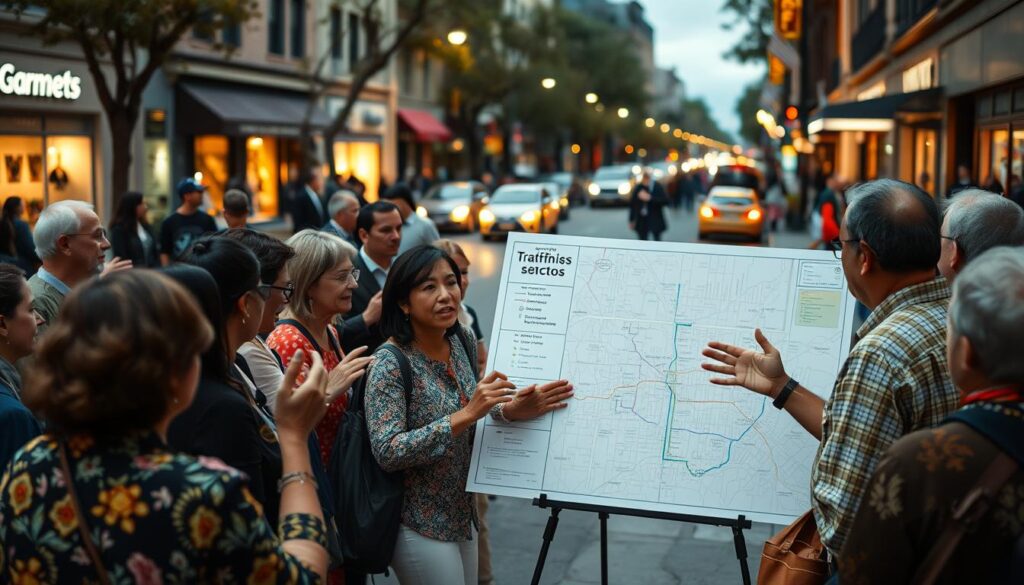
Public Participation and Planning
Public participation is a critical component of traffic planning. It involves engaging with local residents, businesses, and other stakeholders to understand their concerns and aspirations regarding traffic flow and management.
Effective public participation can be achieved through various means, including public meetings, surveys, and online engagement platforms. These mechanisms allow traffic engineers to gather valuable insights and feedback, which can then be used to inform traffic planning decisions.
- Public meetings and hearings
- Online surveys and feedback forms
- Community outreach programs
Feedback Mechanisms and Surveys
Feedback mechanisms are essential for understanding the needs and concerns of the community. Surveys, in particular, provide a structured way to collect data from a wide range of stakeholders.
By analyzing the feedback collected through these mechanisms, traffic engineers can identify key areas for improvement and develop targeted solutions. This not only enhances the efficiency of traffic flow but also improves overall community satisfaction.
Key benefits of community involvement include:
- Increased community support for traffic projects
- More effective and targeted traffic solutions
- Enhanced community engagement and participation
In conclusion, community involvement is a vital aspect of traffic flow engineering. By engaging with the public and incorporating their feedback, traffic engineers can develop effective traffic solutions that meet the needs of local communities.
Advances in Traffic Engineering Research
Traffic engineering research is at the forefront of innovation, addressing the complex challenges of modern transportation. This field is continually evolving, driven by the need for more efficient, safe, and sustainable transportation systems.
Emerging Trends and Innovations
The landscape of traffic engineering is being reshaped by several emerging trends and innovations. One of the most significant is the integration of Artificial Intelligence (AI) and Machine Learning (ML) in traffic management systems. These technologies enable real-time data analysis and predictive modeling, allowing for more efficient traffic flow and reduced congestion.
Another key trend is the development of Intelligent Transportation Systems (ITS), which leverage advanced technologies like sensors, GPS, and communication networks to optimize traffic signal control, incident management, and traveler information systems.
| Innovation | Description | Benefits |
|---|---|---|
| AI and ML in Traffic Management | Real-time data analysis and predictive modeling | Efficient traffic flow, reduced congestion |
| Intelligent Transportation Systems (ITS) | Advanced technologies for traffic signal control and incident management | Optimized traffic signal control, improved incident response |
| Autonomous Vehicles | Vehicles capable of navigating without human input | Potential reduction in accidents, improved traffic flow |
Collaborative Research Projects
Collaborative research projects are crucial in advancing traffic engineering research. By bringing together experts from various disciplines and organizations, these projects facilitate the sharing of knowledge and resources, leading to more effective and innovative solutions.
Examples of collaborative research include the development of smart traffic signals that adjust their timing based on real-time traffic conditions and the creation of mobility-as-a-service platforms that integrate public, private, and shared transportation services.
Challenges in Traffic Flow Engineering
Effective traffic flow engineering requires overcoming obstacles such as traffic congestion and adapting to urban growth. As cities expand and populations increase, the complexity of managing traffic flow intensifies.

Traffic Congestion and Mitigation Strategies
Traffic congestion is a persistent issue in urban areas, leading to increased travel times, air pollution, and decreased quality of life. To mitigate this, traffic engineers employ various strategies, including:
- Optimizing traffic signal timings to reduce congestion
- Implementing intelligent transportation systems (ITS) to monitor and manage traffic flow in real-time
- Promoting alternative modes of transportation, such as public transit, cycling, and walking
Adapting to Urban Growth and Changes
Urban growth presents both challenges and opportunities for traffic flow engineers. As cities evolve, it’s crucial to adapt traffic management strategies to meet changing demands. This includes:
- Conducting thorough traffic studies to understand the impact of urban development on traffic patterns
- Designing flexible transportation systems that can accommodate future growth
- Engaging with the community to understand their needs and preferences
By adopting a proactive and adaptive approach, traffic flow engineers can effectively manage the challenges posed by urban growth and traffic congestion, creating more efficient and sustainable transportation systems.
Future of Traffic Flow Engineering
As we look ahead, traffic flow engineering is poised to undergo significant transformations driven by smart city initiatives and advanced predictive analytics. The integration of these technologies will enable traffic engineers to optimize traffic flow and reduce congestion more effectively than ever before.
The development of smart cities is a crucial factor in the future of traffic flow engineering. Smart cities utilize advanced technologies to manage and monitor traffic flow in real-time, reducing congestion and improving air quality. By leveraging data from various sources, including sensors and cameras, cities can optimize traffic signal timing and implement dynamic traffic management strategies.
Smart Cities and Traffic Dynamics
Smart city initiatives are transforming the way cities manage traffic. By integrating data from various sources, cities can create a more efficient and responsive traffic management system. This includes the use of real-time data to optimize traffic signal timing, manage traffic flow, and reduce congestion.
The role of predictive analytics in traffic flow engineering cannot be overstated. By analyzing historical data and real-time traffic patterns, predictive models can forecast traffic congestion and enable proactive measures to mitigate its impact. This can include adjusting traffic signal timing, rerouting traffic, and implementing other strategies to reduce congestion.
Predictive Analytics and Traffic Forecasting
Predictive analytics is revolutionizing the field of traffic flow engineering by enabling the forecasting of traffic patterns and congestion. By analyzing data from various sources, including traffic sensors and cameras, predictive models can identify potential bottlenecks and enable proactive measures to mitigate their impact.
The application of traffic forecasting models is critical in this context. By accurately predicting traffic flow and congestion, cities can develop more effective traffic management strategies, reducing the economic and environmental impacts of traffic congestion.
In conclusion, the future of traffic flow engineering is closely tied to the development of smart cities and the increasing use of predictive analytics and traffic forecasting. As these technologies continue to evolve, we can expect to see significant improvements in traffic flow and reductions in congestion.
Case Studies: Successful Traffic Flow Improvements
By examining case studies of successful traffic flow improvements, cities can adopt best practices tailored to their unique urban contexts. This approach allows traffic engineers to identify effective strategies that have been implemented in other urban areas, thereby optimizing traffic flow and reducing congestion.
Major U.S. Urban Areas
Several major U.S. cities have made significant strides in improving traffic flow. For instance, Los Angeles has implemented an advanced traffic management system that utilizes real-time data to optimize signal timing, reducing congestion by up to 20% during peak hours.
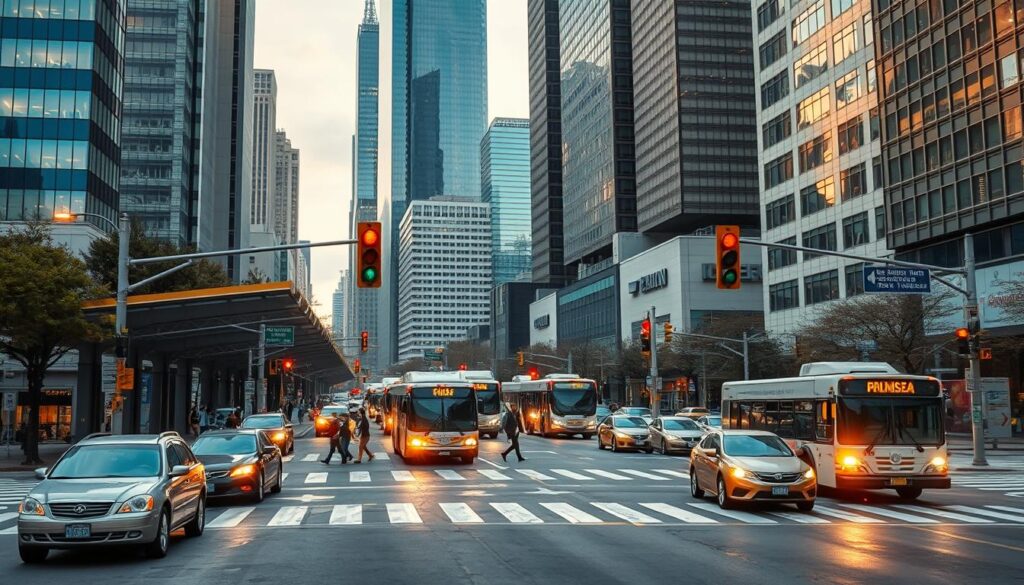
Similarly, New York City has seen improvements through the implementation of congestion pricing, which has not only reduced traffic volume but also encouraged the use of public transportation. According to a report, this initiative has led to a 10% decrease in traffic congestion in Manhattan.
“The key to successful traffic flow improvements lies in understanding the unique dynamics of each urban area and applying tailored solutions.” –
Lessons Learned from Various Implementations
Analyzing the outcomes of these case studies reveals several key lessons. Firstly, the importance of data-driven decision-making cannot be overstated. Cities that have successfully improved traffic flow have done so by leveraging real-time traffic data to inform their strategies.
| City | Strategy Implemented | Outcome |
|---|---|---|
| Los Angeles | Advanced Traffic Management System | 20% reduction in congestion |
| New York City | Congestion Pricing | 10% decrease in traffic volume |
| Chicago | Smart Traffic Signals | 15% improvement in traffic flow |
These case studies demonstrate that with the right strategies and a commitment to data-driven decision-making, urban areas can significantly improve traffic flow, enhancing the quality of life for residents and commuters alike.
The Importance of Multimodal Transportation
Multimodal transportation is not just a trend; it’s a necessity for modern urban planning. As cities continue to grow and evolve, the need for efficient, accessible, and sustainable transportation systems becomes increasingly critical. Multimodal transportation addresses this need by integrating various modes of travel, such as walking, cycling, public transit, and driving, into a cohesive and functional network.
Enhancing Accessibility and Mobility
One of the primary benefits of multimodal transportation is its ability to enhance accessibility and mobility for all users. By providing a range of transportation options, individuals can choose the most convenient and efficient mode of travel for their specific needs. This is particularly important for vulnerable populations, such as the elderly and those with disabilities, who may rely heavily on accessible transportation services.
Accessibility is further improved through the design of transportation infrastructure that accommodates diverse user needs. For example, incorporating pedestrian-friendly and cyclist-friendly infrastructure, such as dedicated bike lanes and accessible pedestrian crossings, encourages the use of non-motorized transport options.
Promoting Non-Motorized Transport Options
Promoting non-motorized transport options is a crucial aspect of multimodal transportation. By investing in infrastructure that supports walking and cycling, cities can reduce their reliance on fossil fuels, decrease traffic congestion, and improve overall air quality. Moreover, non-motorized transport options contribute to a healthier population by encouraging physical activity.
| Mode of Transport | Benefits | Examples of Infrastructure |
|---|---|---|
| Walking | Improves health, reduces congestion | Pedestrian paths, crosswalks |
| Cycling | Environmentally friendly, cost-effective | Dedicated bike lanes, bike-share systems |
| Public Transit | Efficient, reduces traffic congestion | Bus lanes, rail networks, transit hubs |
As illustrated in the table, each mode of transport offers unique benefits and can be supported through targeted infrastructure investments. By promoting a mix of transportation options, cities can create a more sustainable and equitable transportation system.
In conclusion, the importance of multimodal transportation cannot be overstated. By enhancing accessibility and mobility, and promoting non-motorized transport options, cities can develop transportation systems that are efficient, sustainable, and equitable for all users.
Resources for Traffic Flow Engineering Professionals
Traffic flow engineering professionals can leverage various resources to stay updated on the latest developments in the field. These resources enable them to enhance their knowledge and skills, ultimately contributing to more efficient traffic management.
Key Publications
Academic journals such as the Journal of Transportation Engineering and Transportation Research Part C: Emerging Technologies publish cutting-edge research on traffic flow engineering. These publications provide valuable insights into new methodologies and technologies.
Professional Associations and Events
Organizations like the Institute of Transportation Engineers (ITE) offer a platform for professionals to network, share knowledge, and stay informed about industry best practices. Conferences and seminars hosted by these organizations are essential for staying current with the latest trends and advancements in traffic engineering.
By utilizing these traffic engineering resources, professionals can remain at the forefront of their field, driving innovation and improvement in traffic flow management.
